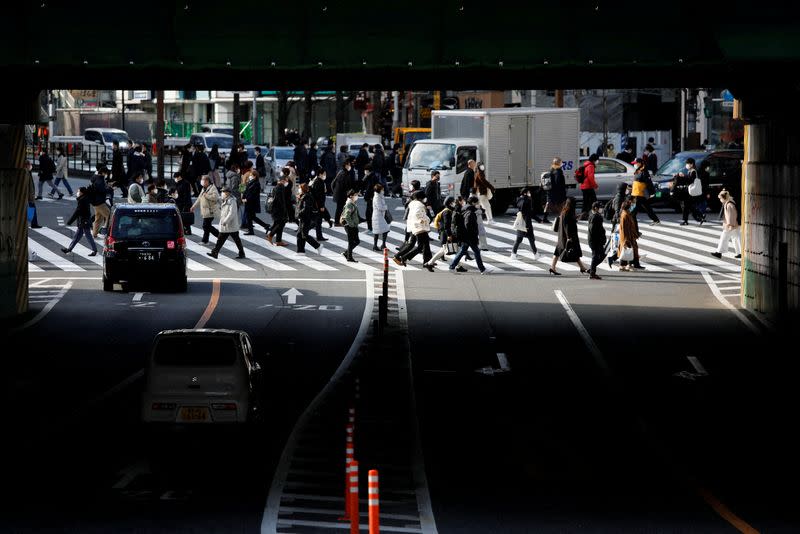As Japan infections surge, so does risk of pandemic fatigue
By Rocky Swift
TOKYO (Reuters) - Japan on Friday acted to contain a record surge in COVID-19 cases with a return to curbs that have however shown diminishing results, while a laggard vaccine booster programme leaves many people vulnerable to breakthrough infections.
The government empowered authorities in Tokyo and 12 other prefectures to implement curbs on mobility and business activity - measures that, with three prefectures already under such devolved restrictions, now cover half of Japan's population.
The highly infectious Omicron variant has driven the current wave of cases, and nationwide infections hit an all-time high of around 46,000 on Thursday.
Japan has declared various levels of emergency multiple times during the two-year pandemic, also including orders for shortened operating hours in bars and restaurants and the banning of alcohol sales.
But studies of cell phone traffic, train usage and other mobility data suggest levels of compliance by the public have steadily decreased.
"I think it is not a big deal, this Omicron," 73-year-old retiree Norio Oikawa told Reuters. "The number of deaths is very low. I think it's like a common cold, or influenza."
While Omicron is much more infectious than previous variants it appears to cause less serious illness. But public health experts still worry that a wave of such cases could still overwhelm the healthcare system.
Japan has fully vaccinated almost 80% of its population, but an increasing number of them are vulnerable to breakthrough infections as they got their shots more than six months ago. A booster programme that would help immunise them against the fast-moving variant has reached less than 2%.
'VERY SLOW' CABINET RESPONSE
The new curbs may have some impact on a public that has adapted to a "new normal" of behaviour over the past two years, said Haruka Sakamoto, a physician and public health researcher at Keio University in Tokyo.
But promoting booster shots, building up testing capacity and protecting essential workers are more critical. "The response in these areas by the Cabinet seems to be very slow," she added.
One doctor told Reuters there appeared to be delays in imports of vaccines for boosters, as Japan depends on overseas drugmakers for almost all of its supplies.
Another pointed to a decision to shut down mass vaccination centres after the main inoculation push last year, and the health ministry's initial insistence on an eight-month gap between first-phase inoculations and booster shots.
Makoto Shimoaraiso, a Cabinet official guiding Japan's pandemic response, said that delays in regulatory approvals and reopening of inoculation sites had hampered the vaccine rollout.
Japan's initial inoculation push started off slowly before reaching up to 1.7 million shots a day last year, and with boosters, "we can also see the same rapid increase," he added.
And compared to previous emergency measure declarations, the government is encouraging the avoidance of certain risky behaviours, such as talking loudly in enclosed areas, rather than a wholesale reduction in activities, he said.
The country has recorded just over 2 million coronavirus cases and 18,461 deaths during the pandemic.
Tokyo's occupancy rate of hospital beds for COVID-19 patients, rose to 31.5% on Friday. An increase to 50% would warrant escalation to a full state of emergency, officials have said.
New infections in the capital jumped to a record of 9,699, and are projected to exceed 10,000 a day by month's end.
"When you look at the infection situation, the quasi-state of emergency is inevitable," said office worker Masayuki Fujii, 49. "However, we have to get the economy going."
(Reporting by Rocky Swift; editing by John Stonestreet)

 Yahoo Movies
Yahoo Movies 

